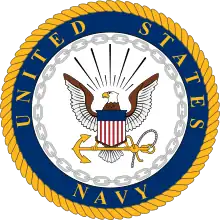Nuclear-powered cruisers of the United States Navy
The United States Navy at one time had nuclear-powered cruisers as part of its fleet. The first such ship was USS Long Beach (CGN-9). Commissioned in late summer 1961, she was the world's first nuclear-powered surface combatant.[1] She was followed a year later by USS Bainbridge (DLGN-25). While Long Beach was a 'true cruiser', meaning she was designed and built as a cruiser,[2] Bainbridge began life as a frigate, though at that time the Navy was using the hull code "DLGN" for "destroyer leader, guided missile, nuclear".[3] This was prior to the enactment of the 1975 ship reclassification plan, in which frigates (DLG/DLGN), (which were essentially large destroyers), were reclassified as cruisers, so that the US Navy's numbers would compete with those of the Soviet Navy.[4] Long Beach, the largest of all the nuclear cruisers, was equipped with a C1W cruiser reactor, while all the others were equipped with D2G destroyer reactors.
%252C_USS_Long_Beach_(CGN-9)_and_USS_Bainbridge_(DLGN-25)_underway_in_the_Mediterranean_Sea_during_Operation_Sea_Orbit%252C_in_1964.jpg.webp)
In the summer of 1964, Long Beach and Bainbridge would meet up with USS Enterprise (CVAN-65), the Navy's first nuclear-powered aircraft carrier,[5] to form Task Force One, an all-nuclear-powered naval unit. They would commence Operation Sea Orbit, in which they circumnavigated the globe, without refuelling. It was a remarkable achievement for its time, a naval group capable of sailing over 48,000 kilometers (26,000 nmi; 30,000 mi) in just 65 days, without replenishment.[6]
In the spring of 1967 came the Navy's third nuclear-powered cruiser, (though initially labeled a frigate), USS Truxtun (DLGN-35), a heavily modified design based on the Belknap-class cruiser. Truxtun would be followed by the 2-ship California class, beginning with USS California (CGN-36) in February 1974 and USS South Carolina (CGN-37) in January 1975. The US Navy was the only fleet in the world with nuclear-powered cruisers, until 1974 when the USSR would begin construction on their own nuclear battlecruiser, the Kirov class. The Soviets would build 4 in total, between 1974 and 1998.[7]
The last nuclear-powered cruisers the Americans would produce would be the 4-ship Virginia class. USS Virginia (CGN-38) was commissioned in 1976, followed by USS Texas (CGN-39) in 1977, USS Mississippi (CGN-40) in 1978 and finally USS Arkansas (CGN-41) in 1980. Ultimately, all these ships would prove to be too costly to maintain[8] and they would all be retired between 1993 and 1999. A fifth Virginia-class vessel was initially planned but then cancelled.[9]
The US Navy currently has the largest fleet of nuclear-powered aircraft carriers[10] and nuclear-powered submarines.[11]
List of United States Navy nuclear-powered cruisers
| Ship Name | Hull Number | Class | Length | Displacement | Commissioned | Decommissioned | Service Life | Notes |
|---|---|---|---|---|---|---|---|---|
| USS Long Beach | CGN-9 | Long Beach | 721 ft 3 in (219.84 m) | 15,540 tons | 9 September 1961 | 1 May 1995 | 33 years, 7 months and 23 days | |
| USS Bainbridge | CGN-25 | Bainbridge | 565 ft 0 in (172.21 m) | 9,100 tons | 6 October 1962 | 13 July 1996 | 33 years, 9 months and 7 days | |
| USS Truxtun | CGN-35 | Truxtun | 564 ft 0 in (171.91 m) | 8,659 tons | 27 May 1967 | 11 September 1995 | 28 years, 3 months and 15 days | |
| USS California | CGN-36 | California | 587 ft 0 in (178.92 m) | 10,800 tons | 16 February 1974 | 9 July 1999 | 25 years, 4 months and 23 days | |
| USS South Carolina | CGN-37 | California | 587 ft 0 in (178.92 m) | 10,800 tons | 25 January 1975 | 30 July 1999 | 24 years, 6 months and 5 days | |
| USS Virginia | CGN-38 | Virginia | 586 ft 0 in (178.61 m) | 11,666 tons | 11 September 1976 | 10 November 1994 | 18 years, 1 month and 30 days | |
| USS Texas | CGN-39 | Virginia | 586 ft 0 in (178.61 m) | 11,666 tons | 10 September 1977 | 16 July 1993 | 15 years, 10 months and 6 days | |
| USS Mississippi | CGN-40 | Virginia | 586 ft 0 in (178.61 m) | 11,666 tons | 5 August 1978 | 28 July 1997 | 18 years, 11 months and 23 days | |
| USS Arkansas | CGN-41 | Virginia | 586 ft 0 in (178.61 m) | 11,666 tons | 18 October 1980 | 7 July 1998 | 17 years, 8 months and 19 days |
_underway_at_sea%252C_circa_in_the_1960s.jpg.webp) USS Long Beach
USS Long Beach
(CGN-9)_underway_in_the_Suez_Canal_on_27_February_1992.jpg.webp) USS Bainbridge
USS Bainbridge
(CGN-25)_underway_off_Point_Loma%252C_California_(USA)%252C_circa_in_the_1970s.jpg.webp) USS Truxtun
USS Truxtun
(DLGN-35).JPG.webp) USS California
USS California
(CGN-36)_elevated_starboard_view.jpg.webp) USS Virginia
USS Virginia
(CGN-38)_underway%252C_circa_in_the_early_1980s.jpg.webp) USS Arkansas
USS Arkansas
(CGN-41)
See also
- List of United States Navy ships
- Nuclear propulsion
- Nuclear navy
- Cold war
- Supercarrier
- Nuclear submarine
- USS Nautilus (SSN-571) (World's first nuclear-powered submarine)
- USS Enterprise (CVN-65) (World's first nuclear-powered aircraft carrier)
References
- "USS Long Beach (CGN 9)".
- John Pike. "CGN-9 Long Beach".
- John Pike. "CGN 25 BAINBRIDGE class".
- "sci.military.naval FAQ, Part F - Surface Combatants".
- "USS Enterprise (CVN 65) Official Web Site". Archived from the original on 2013-03-01.
- "Operation Sea Orbit Celebration: A Legacy Like No Other - Naval Historical Foundation".
- John Pike. "Kirov Class - Project 1144.2".
- "Nuclear power for surface combatants".
- John Pike. "CGN-42 AEGIS Modified Virginia".
- Kyle Mizokami (25 January 2016). "Here Is Every Aircraft Carrier in the World". Popular Mechanics.
- News Editor (15 January 2016). "The 9 Largest Submarine Fleets in the World".
External links
| Wikimedia Commons has media related to United States Navy. |
